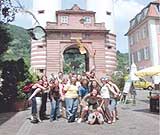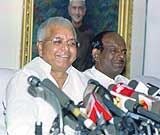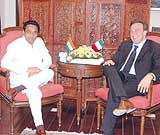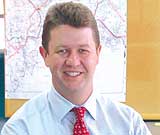GERMANY AND INDIA
SCHOOL IN GERMANY NAMED AFTER TAGORE |

|
| Impressed with Rabindranath Tagore’s literary stuff, a Berlin school has decided to rename itself as Tagore School |
 Germany’s long-standing interaction with India has reached a new high with staff and students of a school in Berlin deciding to rename their institution after Nobel Laureate Rabindranath Tagore. Germany’s long-standing interaction with India has reached a new high with staff and students of a school in Berlin deciding to rename their institution after Nobel Laureate Rabindranath Tagore.
Oberschule an der Weide, a gymnasium school offering education up to 13th grade, has nearly 1,000 students and 65 teachers. The story of renaming the school after Tagore began in 2004 when students came across his personality and work as part of a project on major international personalities.
Impressed with Tagore, the students conducted further research and involved themselves in India Day celebrations organised by the Indian Embassy here on September 30, 2004. They presented a series of lectures, cultural programmes and presentations on Tagore.
The school management later debated on the name for nearly one year. The local authorities have ratified the decision to rename the school as Tagore School. The formal inauguration of the school’s new incarnation was attended by Indian Ambassador Meera Shankar and several prominent Indians and Germans, including the mayor of borough Marzahn-Hellersdorf (in Berlin) and Ravindra Gujjula, Indo-German mayor of Altlandesberg. |
|
|
| LALU ZIPS BETWEEN ROME AND NAPLES, SIGNS MoU |
 |
Railway Minister Lalu Prasad Yadav visited Italy and met Government officials and other senior dignitaries in Rome, where the MoU between Italian Railways and the Indian Ministry of Railways was signed.
Officials said the MoU will provide an institutionalized and structured exchange of information in different areas of interest including a platform to receive the latest technological advancements and information regarding ongoing research and development in various fields such as operation and maintenance of Railways, safety and security.
Lalu also undertook a 210 kilometre journey from Rome to Naples on a high-speed train, cruising at 310 kilometres per hour.
He also had a ride in the train’s engine. Lalu later met the Italian Minister of Infrastructure, Antonio Dietro and briefed him about the modernization programme being initiated by the Indian Railways. Lalu further proposed that Italian companies should join hands with IRCON and RITES for joint bidding in the field of construction and consultancy in other countries.
Dietro invited the Italian Railway Team to visit India in August 2006 to achieve further progress in implementing the MOU reached between the two countries. |
|
ITALY AND INDIA
ITALY SEEKS CLOSER ECONOMIC ENGAGEMENT WITH INDIA |

|
 Italy has expressed its keenness to promote closer trade and economic ties with India and further increase bilateral trade volume. Italy has expressed its keenness to promote closer trade and economic ties with India and further increase bilateral trade volume.
Italian Minister of State for Foreign Affairs Sen Gianni Vernetti said at a meeting with Commerce and Industry Minister Kamal Nath that there was potential for doing much more and the new government in Italy would work towards further deepening and broadening bilateral ties.
Bilateral trade between the two countries in 2005-06 was $4.3 billion, showing a growth of about 18 per cent over the previous year, an official release said here today.
Nath highlighted the scope for Italian investment in infrastructure projects. Foreign Direct Investment (FDI) approved from Italy to India (1991-March 2006) amounted to $ 1.34 billion, of which actual inflows were only $ 500 million.
Vernetti indicated that the Italian Prime Minister would be visiting India early next year and it would provide an opportunity to carry the dialogue on bilateral trade and economic cooperation to higher levels. |
|
|
NEW ZEALAND AND INDIA
NEW ZEALAND UPS ITS IMMIGRATION INTAKE, AND INDIANS ARE PREFERRED |

|
| With skilled labour in short supply down under, New Zealand opens its immigration gates for Indians |
 New Zealand has included India and China in its list of preferred countries for migrant workers in areas of “absolute skill shortage”. New Zealand has included India and China in its list of preferred countries for migrant workers in areas of “absolute skill shortage”.
Announcing this on the last day of June, New Zealand Communications Minister David Cunliffe said the country’s immigration intake level would be increased to 52,000 for the next one-year period, the highest since 2001-02. In 2005-2006, it was 50,000, but was raised to 51,500 in December last year following complaints from employers about skill shortage.
The areas of “absolute skill shortage” are those that show a worldwide shortage of skilled workers with no signs of easing in the near future. These include information technology, plumbing and engineering.
According to a report in the Radio New Zealand website, Cunliffe said skilled and business immigrants were being allocated 60 per cent of the new target, with family reunion and sponsored migrants accounting for 30 per cent.
“More vacancies will be filled. This will help employers who continue to say skill shortages are a constraint to the growth of their businesses, and will contribute to economic growth,” another report quoted Cunliffe as saying. |
|